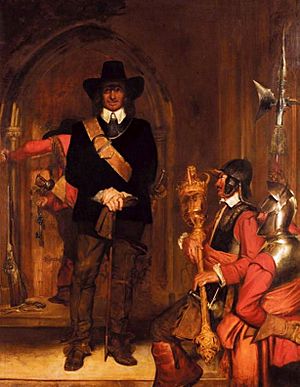Lady Hester Pulter facts for kids
Lady Hester Pulter (born Ley) (1605–1678) was a poet and writer who lived in the 1600s. Her writings were lost for a long time until her main book of poems was found in 1996 at the Brotherton Library at the University of Leeds. Her most important works include "Poems Breathed Forth By the Noble Hadassas" and "The Unfortunate Florinda."
Contents
About Her Life
Her Birth
Lady Hester Pulter was born on June 18, 1605. She was born in a place called St. Thomas Court, near Dublin, in Ireland. She was baptized the next day at St. Katherins church. For a long time, people weren't sure exactly when she was born. Some of her own writings made it seem like she was born earlier or later. However, a special family record clearly states her birth date in 1605.
Her Family and Home
Hester was the daughter of James Ley, who later became the first Earl of Marlborough. Her mother was Mary, James Ley's first wife. Hester was one of eleven children in her family.
In 1623, when she was about 18 years old, Hester married Arthur Pulter. After getting married, she spent the rest of her life at Broadfield Hall, a large house near Cottered in Hertfordshire, England. (See a picture of Broadfield Hall here) Hester and Arthur Pulter had fifteen children together. Sadly, only two of their children lived longer than Hester.
During the English Civil Wars (a big conflict in England), the Pulter family tried to stay out of public life. Arthur wanted to remain neutral, meaning he didn't pick a side in the war. However, Hester didn't stay quiet like her husband. She started writing poems about politics during the 1640s and 1650s.
Lady Hester Pulter passed away in 1678. We don't know the exact date, but she was buried on April 9, 1678. Her husband, Arthur, lived longer than Hester and most of their children. He died in 1689. Their only grandson, James Forester, became the family's heir.
Her Writing Career
Before 1996, Lady Hester Pulter was not known as a writer in British literature. Her family was only mentioned in a history book about Hertfordshire.
Pulter's writings are mostly about the English Civil Wars. She wrote from a "royalist" point of view. This means she supported King Charles I, who wanted to protect the traditional church and government in England.
Lady Hester Pulter used the pen name Hadassas (which comes from the biblical name Esther). She wrote about 130 pages of poetry and 30 pages of an unfinished story. Many of her poems were about the death of King Charles I. In these poems, she spoke out against those who killed him and praised the king.
Her Literary Works
In the mid-1990s, a researcher named Mark Robson found "Poems breathed forth by the Noble Hadrassas" and "The Unfortunate Florinda." These were previously unknown works by Pulter, found in the Leeds University Brotherton Library.
The Leeds manuscript contains about 130 pages of poems and 30 pages of an unfinished story called "The Unfortunate Florinda." (See a picture of the manuscript here) It was likely written between the 1640s and 1650s. The manuscript shows that Hester was very knowledgeable about writing and astronomy. It also shows her strong support for the Royalist side during the war. Unlike her husband, Hester was not quiet about her political beliefs. Her poems clearly showed her anger about King Charles I's death.
"Poems breathed forth by the Noble Hadassas"
(See a page from the manuscript here)
The first part of her main collection, about 90 poems, was called Poems breathed forth. A smaller part within this was called Hadassas Chast Fances. The second part, with about 40 poems, was titled The Sighes of a Sad Soule Emblematically Breath'd Forth. These poems are mostly lyrical (like songs) and occasional (written for specific events).
Lady Pulter's poetry is special because she often mixed personal feelings, political ideas, and themes about planets and stars. For example, she wrote about her own sadness and the sadness of the nation at the same time. She believed that her personal life and political events were connected. This is shown when poems about her daughter's death appear after poems mourning other Royalists. Lady Pulter seemed to want her readers to think that the loss of her children and the loss of Royalists were both linked to the destruction caused by the English Civil War.
"The Unfortunate Florinda"
The last part of the Leeds manuscript was called The Unfortunate Florinda. This was a prose romance, which is a type of story. It was left unfinished and was written between 1661. It seems to have been written after her main collection of poems. This story might have been a second idea, as it was written from the back of the book. The way it was put together suggests that Hester might not have thought The Unfortunate Florinda was as important as her poems.
Astronomy in Her Works
Hester Pulter was very interested in the new discoveries about space and planets made in the 1600s. She included ideas about astronomy in many of her poems. Poems like "Universal Dissolution" and "The Revolution" show her interest in images of stars and planets. Pulter used her knowledge of astronomy to think about spiritual ideas in her daily life. She saw planets as important to life on Earth, believing they were all connected.
Circle Shapes in Her Works
Circles and images of circles appear many times in Lady Pulter's writings. Some examples are found in poems like "The Circle" and "The Eclipse." The idea of circles shows her interest in religious, scientific, and astronomical ideas. The theme of things repeating or returning to a beginning is often present in her work.


